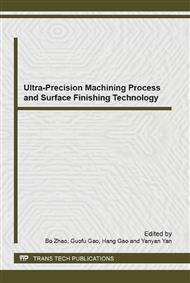[1]
Yang Shichun, Wang Mingzheng, Yang Shengqian, Surface quality and barreling processing technology. Shangdong I. C. E, 2001 (1), 14-16.
Google Scholar
[2]
Chen Zhenyu, Wang Guicheng, Studying status of burr and deburring technology, Modern Manufacturing Engineering, 2004 (2), 126-128.
Google Scholar
[3]
Silvia Maria BOOIJ, Fluid Jet Polishing-possibilities and Limitations of a New Fabrication Technique [D]. Netherlands: Delft University.
Google Scholar
[4]
W.S. Luo, C.Y. Wang, J. Wang and Y.X. Song, The Development of Micro Abrasive Waterjet Machining Technology. Advanced Materials Research, Vol. 188 (2011), pp.733-738.
DOI: 10.4028/www.scientific.net/amr.188.733
Google Scholar
[5]
Xue Shengxiong. High pressure water jet technology and application[M]. Beijing: China Machine Press 1998, 1-42.
Google Scholar
[6]
Yang Peixuan, Study on micro abrasive suspension jet processing technology, Dissertation for master degree of Engineering Guangdong University of Technology, 2008. 5.
Google Scholar
[7]
Liu Lihong, Zhang Dongsu, Study on Jet stream with grinding materials clean pressure vessel oxide, Chemical Machinery, 1996, 24(2): 77-79.
Google Scholar
[8]
J. B Zu,G. T. Burstein, Hutchings, A comparative study of the slurry erosion and free-fall particle erosion ofaluminu, 1991, (149): 73-84.
DOI: 10.1016/0043-1648(91)90365-2
Google Scholar
[9]
Zhong Shengyu, Liao Qidian, Zhu Yong, Effect of nozzle shape on the properties of high pressure water jet, Vol. 2, No. 4, 1987. 12.
Google Scholar
[10]
Back L. H, Laminarization of a turbulent boundary layer in nozzle flow, AIAJJ, (1969).
Google Scholar
[11]
Fang Hui, Guo Peiji, Yu Jingchi, Research on material removal mechanism of fluid jet polishing, Vol. 30, No. 2, 2004. 3.
Google Scholar
[12]
B. Ekkard,R. Oltmanm and G. aLElexander. finishing of structured surfaces by abrasive polishing[J]. precision Engineering, 2006, 30: 325-336.
DOI: 10.1016/j.precisioneng.2005.11.012
Google Scholar
[13]
Henk Wensink and Miko C. Elwenspoek. A closer look at the ductile-brittle transition in solid particle erosion[J]. wear, 2002, 253: 1035-1043.
DOI: 10.1016/s0043-1648(02)00223-5
Google Scholar


